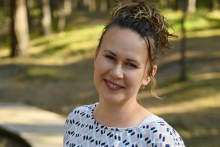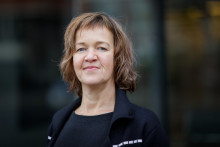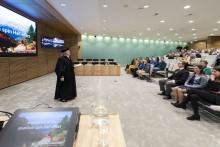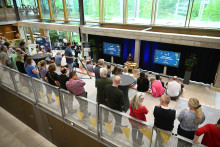‘We might not see them, but they do everything for us,’ says Mélody Rousseau about the primary focus of her research. The PhD candidate studies soil biodiversity, meaning microorganisms such as bacteria, fungi, and invertebrates that live in the ground. ‘They have many functions. For instance, they recycle nutrients which feed plants. Without them, there are no plants. And without plants, there is nothing else. And so, even though we might not think about them, these microorganisms are what we need for life on this planet.’
Biodiversity of forests
Rousseau’s doctoral research is part of a large ERC funded project BIOSPACE that aims to monitor biodiversity by using new methods, such as next generation satellite remote sensing. Her goal, specifically, is to assess and map the diversity and distribution of soil organisms in European temperate forests.
mélody rousseau
PhD research topic: Assessing and mapping soil biodiversity in European temperate forests, using innovative techniques like metabarcoding, GIS, and remote sensing
Work: PhD candidate at the Department of Natural Resources, Faculty of Geo-Information Science and Earth Observation (ITC) at the University of Twente
Education: Master's degree in Ecology, Vrije Universiteit Amsterdam
Originally from: France
While we have a general understanding of soil microorganisms and their functions, there is still a lot of knowledge to be uncovered, says Rousseau. ‘We don’t know what species can be found in which ecosystems and how their functions are impacted by changes in the ecosystem. If we gain this overview, we can get a better understanding of soil functions, and how they influence our forests’ health. If we know this, we can act on it. Forests are very important for carbon storage, and so it’s important to know under which conditions they thrive.’
Remote sensing
The UT researcher aims to do this by using innovative techniques like metabarcoding, GIS, and remote sensing. In other words, she plans to monitor soil microorganisms from space. ‘Of course, it’s impossible to see microorganisms from satellite data. We can’t even see them when standing on the ground. However, we are able to get a lot of other information from remote sensing data,’ explains Rousseau. For instance, it’s possible to get information on structural and biochemical characteristics of forests, such as data on chlorophyll and nitrogen content of the forest, the canopy cover, and the height of trees.
‘Microorganisms in the soil are influenced by all these conditions,’ says Rousseau. ‘For example, when the leaves fall down on the ground and decompose, there are differences in nutrient content present in the soil depending on the tree species where the leaves come from. Therefore, we can tell a lot about the soil microorganisms based on the environment that we can see.’
'We can see that soils are extremely diverse compared to other parts of the ecosystem'
Monitoring the condition of soil from space has many advantages, adds the PhD candidate. ‘These methods allow us to get information on a much larger scale. It makes it easy to get information over a period of time, and to track any developments. This way, we can see any changes faster and easier than with other methods.’
Gloves, bleach and DNA
However, Rousseau certainly doesn’t only spend her days looking at satellite images on the screen. As part of her PhD project, she collected a lot of DNA samples in various forests. Equipped with a cool box, countless gloves and a lot of bleach, she hiked through the Veluwe area in the Netherlands and the Bavarian Forest National Park in Germany. ‘During data collection, the most important thing is to not contaminate your samples,’ she says. ‘We wear one pair of gloves for one sample, and we clean our equipment with bleach every time. Because, like you probably saw on TV, bleach gets rid of DNA.’
This data collected in the field will be combined with remote sensing data in order to get a better insight into the state of soil biodiversity, explains Rousseau. ‘I’m still analysing everything, and so we don’t have any final results, but we can see that soils are extremely diverse compared to other parts of the ecosystem. Even so, soil in Veluwe was generally quite acidic and we observed a loss of biodiversity there. This is troublesome because it can lead to loss of soil functions, altering the forest’s health.’
Everything is connected
As she says, Mélody Rousseau enjoys working on such an applied research topic. ‘I’ve always been interested in ecosystem functioning. I find it fascinating. Everything in an ecosystem is connected to each other. You disrupt one thing and everything else follows. I like examining these links and the complexity of it. I really enjoy this project because it is practical and also cutting edge. The combination of DNA data and remote sensing is new, and it can be hard to understand that you can map DNA information from space – it’s not something that was done before.’
'Understanding biodiversity of soil microorganisms is crucial'
Rousseau also believes that the research can have a real impact. ‘If we can get a better understanding of microorganisms in soil, it will become easier to monitor biodiversity in general,’ she says. ‘Right now, there is still a lot that we don’t know about biodiversity and its status. It’s hard to say if something is going well or not, and what could be done about it. Once we have a clearer picture, we can help protect biodiversity.’
And we should start from the ground up, so to speak. ‘Understanding biodiversity of soil microorganisms is crucial because microorganisms are everywhere,’ says the UT researcher. ‘Plants and animals are very important too, but microorganisms provide us with all ecosystem services. They can also help us from an agricultural point of view. We have somehow exhausted our soils, but the right microorganisms can help us make them more fertile again. There is still so much to learn about them, and what they can do for us – and it’s essential. It’s the way forward.’








